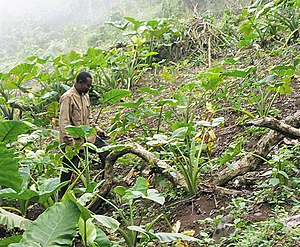Subsistence agriculture

Subsistence agriculture is self-sufficiency farming in which farmers focus on growing enough food to feed their families. The typical subsistence farm has a range of crops and animals needed by the family to eat during the year. Planting decisions are made with an eye toward what the family will need during the coming year, rather than market prices. Tony Waters[1] writes: "Subsistence peasants are people who grow what they eat, build their own houses, and live without regularly making purchases in the marketplace."
Subsistence grain-growing agriculture (predominantly wheat and barley) first emerged during the Neolithic Revolution when humans began to settle in the Nile, Euphrates, and Indus River Valleys. It was the dominant mode of production in the world until recently, when market-based capitalism became widespread. Subsistence horticulture may have developed earlier in South East Asia and Papua New Guinea..
Subsistence farming continues today in large parts of up-country Africa,[2] and other countries of Asia and Latin America. Subsistence agriculture had by large disappeared in Europe by the beginning of World War I, and in North America with the movement of sharecroppers and tenant farmers out of the American South and Midwest during the 1930s and 1940s.[1] In Central and Eastern Europe subsistence and semi-subsistence agriculture reappeared within the transition economy since about 1990.[3]
Subsistence agriculture is of a few types:
a) Primitive Type: This type used to be practised in the past in backward Equatorial areas. In this type, farmers use simple tools and primitive techniques to grow food for their own use.
b) Shifting agriculture or Slash and Burn or Jhooming: In this type of agriculture, mostly practised in Northeast India, a patch of forest land is cleared by burning and crops are grown. After 2-3 years, when the fertility of the soil is exhausted, the land is abandoned and the farmer moves to a fresh piece of land and the process continues. After 10-15 years the farmer may return to the first piece of land. This is a very crude and primitive method resulting in large scale deforestation and soil erosion. This type of agriculture has now been banned by the government.
c)Intensive Subsistence Farming:In very densely populated countries like India and China, farmers are forced to use the small land holding to produce enough for their own consumption, the little remaining produce is used for exchange against other goods. These farmers try to obtain maximum yield from the available lands. They use manure, artificial irrigation and animal waste as manure.
See also
- Commercial agriculture
- Industrial agriculture
- Cash crop
- Hoe-farming
- Opium replacement
- Slash and burn
- Subsistence fishing
References
- ^ a b Tony Waters. The Persistence of Subsistence Agriculture: life beneath the level of the marketplace. Lanham, MD: Lexington Books. 2007.
- ^ Goran Hyden. Beyond Ujamaa in Tanzania: Underdevelopment and an Uncaptured Peasantry. Berkeley: University of California Press. 1980.
- ^ Steffen Abele and Klaus Frohberg (Eds.). "Subsistence Agriculture in Central and Eastern Europe: How to Break the Vicious Circle?" Studies on the Agricultural and Food Sector in Central and Eastern Europe. IAMO, 2003.
- Charles Sellers. The Market Revolution: Jacksonian America, 1815-1846. New York: Oxford University Press. 1991.
- Howard, Sir Albert. (1943) An Agricultural Testament. Oxford University Press.
